Table of Contents (click to expand)
- The Opening Scene
- Satellite Debris Hitting The Space Shuttle Explorer
- The Hubble Telescope, ISS And Tiangong-1 Are Located Close To Each Other
- Space Debris Can Cause Hazardous Accidents
- Space Stations Can Fall Out Of Orbit
- Dr. Stone’s Tears
- Earth’s Atmosphere Relative To Earth’s Size
- Dr. Stone’s Clothing
- Using A Fire Extinguisher As A Hand-held Jetpack
- 90 Minutes’ Orbital Time
- The “You Have To Let Me Go” Moment
‘Gravity’ is generally considered to be quite accurate from a scientific standpoint, with some minor exceptions. One of the most notable inaccuracies is the depiction of how quickly and easily Dr. Stone is able to remove her spacesuit. Also, the Hubble Telescope, International Space Station, and China’s Tiangong-1 are located in different orbits and at different heights.
Gravity, a 2013 blockbuster flick, received an overwhelming response and garnered adulation for its realistic depiction of the various conditions and challenges faced by astronauts in space. The movie traces the journey of two astronauts to save themselves after their shuttle gets clobbered by space debris from a destructed satellite.
As much as we all loved watching Gravity, it’s important that we get you acquainted with various scientific aspects depicted in the movie and see how realistic this film really is. So, let’s take it from the top.
The Opening Scene

In the opening scene of the movie, three astronauts, including Dr. Ryan Stone (played by Sandra Bullock) and Lieutenant Matt Kowalski (played by George Clooney), are seen spacewalking and having a nice, informal chat. Moreover, Kowalski is roaming all over the place using what’s supposed to be a MMU (Manned Maneuvering Unit) as his personal jetpack.
There are several problems in this scene. First off, the ‘jetpack’ (of sorts) that Kowalski is adhered to is quite different from a real MMU, whose usage in space missions was discontinued in the 1990s anyway. In some other shots, the jetpack looks more like SAFER or ‘Simplified Aid for EVA Rescue’, which looks somewhat similar to an MMU, but with significant structural differences.
Here is an image of both an MMU and SAFER, so you can compare it to the cool jetpack Kowalski is sporting.
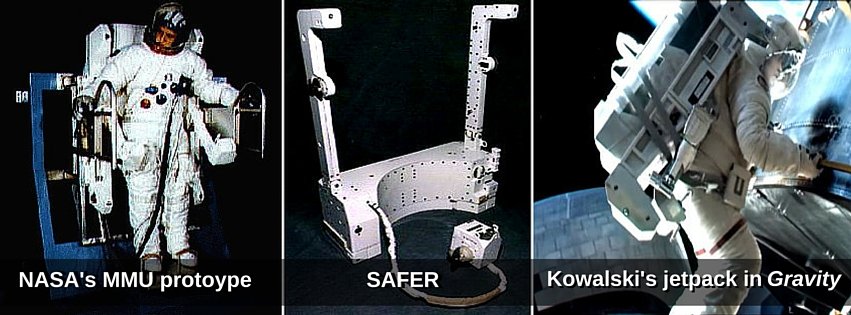
Notice the difference?
Furthermore, spacewalks are highly choreographed and practiced several times in simulated conditions before an astronaut actually goes into space. Every action during spacewalks is premeditated in order to avoid unnecessary ‘ambling’ and minimize the use of oxygen (whose supply, of course, is limited). Therefore, in a real life space-mission, an astronaut zipping around wisecracking is…

Scientific verdict: False
Also Read: What Really Happened In The Apollo 13 Disaster?
Satellite Debris Hitting The Space Shuttle Explorer
This is a notorious yet immensely pivotal scene that triggered the havoc that doomed the space shuttle Explorer. It goes like this:
The crew members of the space shuttle Explorer are servicing the Hubble Space telescope. Suddenly, they are informed by Mission Control, Houston that a cloud of debris (caused by the destruction of a defunct Russian satellite) is headed for their location; they are advised to abort the mission to avoid a nasty collision.
The Hubble Space Telescope (the telescope they are servicing) orbits at a height of around 560 kilometers above the Earth. Their shuttle, which is running the risk of getting hit by a destroyed Russian satellite, is also at the same height. But, wait! These types of communication satellites, which go by the name TDRSS (Tracking and Data Relay Satellite System), stay in the ‘geosynchronous orbit’, which is much higher; almost 35,000 kilometers above Earth.
To better visualise the scales of the distance between the orbits, take a look at the following image taken from a point above Earth:
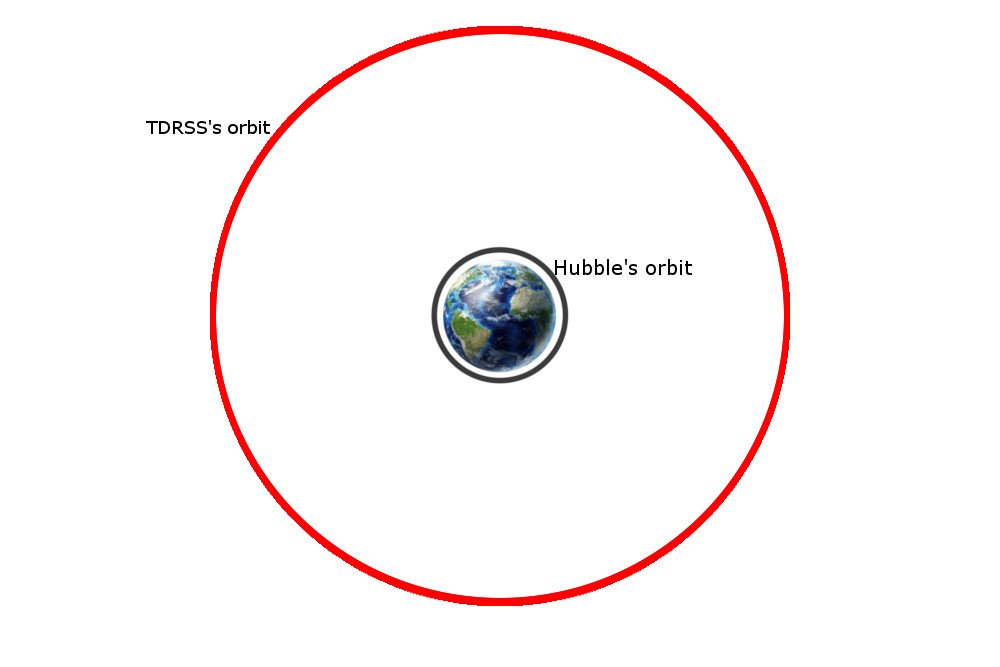
So how could the debris of a satellite so high above Earth bump into a shuttle orbiting so low?
The other thing is inclination; the Hubble orbits the Earth at 28.5 Degrees, whereas communication satellites orbit at a much higher inclination. There is some chance of the debris hitting their shuttle, but not right away, and certainly not every 90 minutes!
Scientific verdict: False.
Also Read: Graveyard Orbit: What Happens When Artificial Satellites Die?
The Hubble Telescope, ISS And Tiangong-1 Are Located Close To Each Other
Dr. Stone and Kowalski head for the ISS after their shuttle is hit, and later in the movie, Dr. Stone makes her way to China’s Tiangong-1 without much difficulty. All of this may lead you to believe that these three structures, namely The Hubble, ISS and Tiangong-1, are located close to each other, but this is far from true. In fact, these three man-made structures are not only at different heights, but also lie in different orbits around Earth.
Scientific verdict: False.
Also Read: Can Man-Made Objects Be Seen From Space?
Space Debris Can Cause Hazardous Accidents
Space debris is a very real operational threat to current and future space missions; it can indeed cause uncontrolled collisions between objects present in LEO (Lower Earth Orbit; the orbit that encloses every orbit below 2000 kilometers).
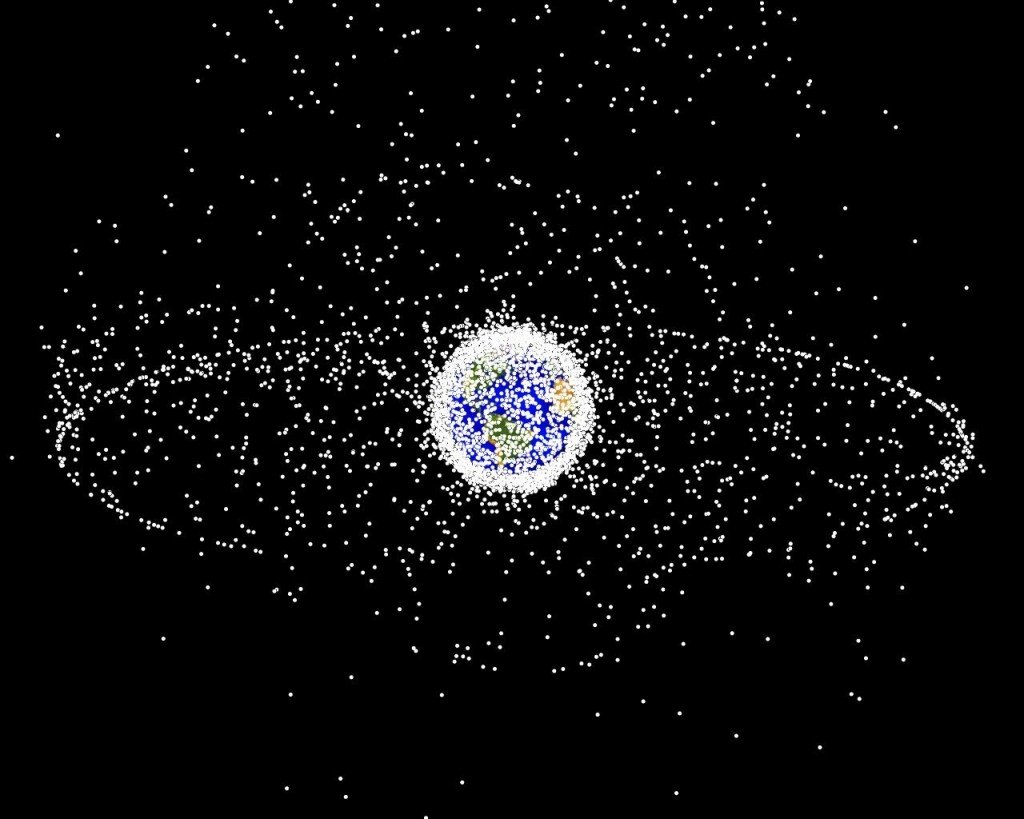
Kessler Syndrome (the name given to the excess “trash” in the orbit that could potentially cause problems) in its most drastic state could cause the world to plunge into a communication blackout (including the absence of cell phone reception and Internet connectivity) for days on end.
Scientific verdict: True
Space Stations Can Fall Out Of Orbit

This is all due to atmospheric drag; satellites that fly close to Earth experience some drag, and can fall out of orbit. However, this is not a singular event that occurs all of a sudden; rather, it’s a process that takes a few years. That’s why ISS has to be artificially boosted from time to time so that it doesn’t fall into Earth’s atmosphere and burn up.
Scientific verdict: True
Dr. Stone’s Tears
In the movie, Dr. Stone’s tears roll down her face and then float off it.
But it doesn’t really happen that way.
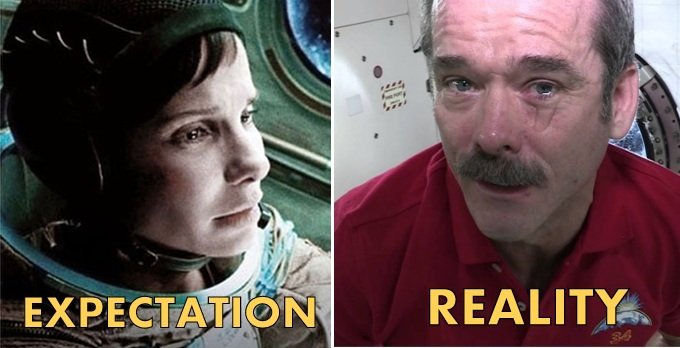
For a more accurate description of how it really happens, you may want to check out What Happens to Your Tears if You Cry in Space?
Scientific verdict: False
Earth’s Atmosphere Relative To Earth’s Size
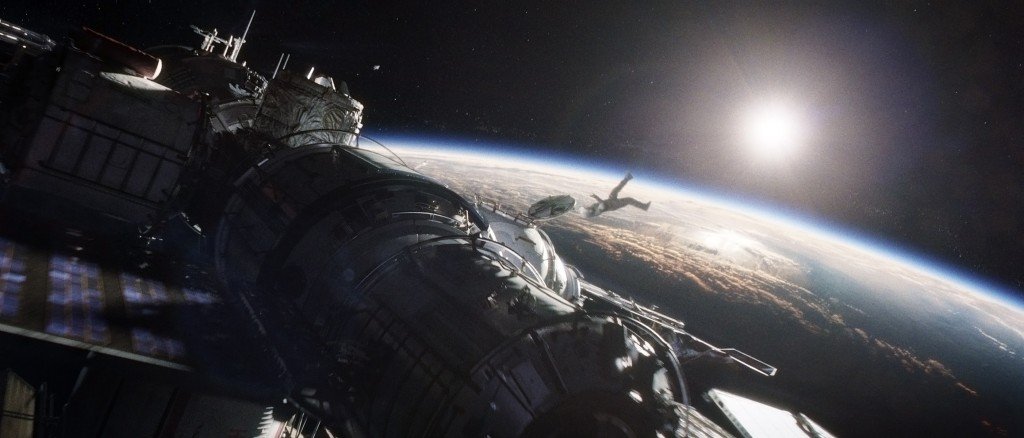
Within the film, the fantastic shots of Earth enveloped by a thin, translucent layer of atmosphere are truly mesmerizing. The best thing is that they have correctly depicted the atmosphere’s thinness relative to Earth’s size without any exaggeration in the movie.
Scientific verdict: True
Dr. Stone’s Clothing
This is one of the most glaring errors of the movie. In one of the scenes, Dr. Stone strips off her spacesuit in just a few seconds and is then seen wearing only shorts and a tiny shirt. In a real-life space mission, however, this is far from possible.
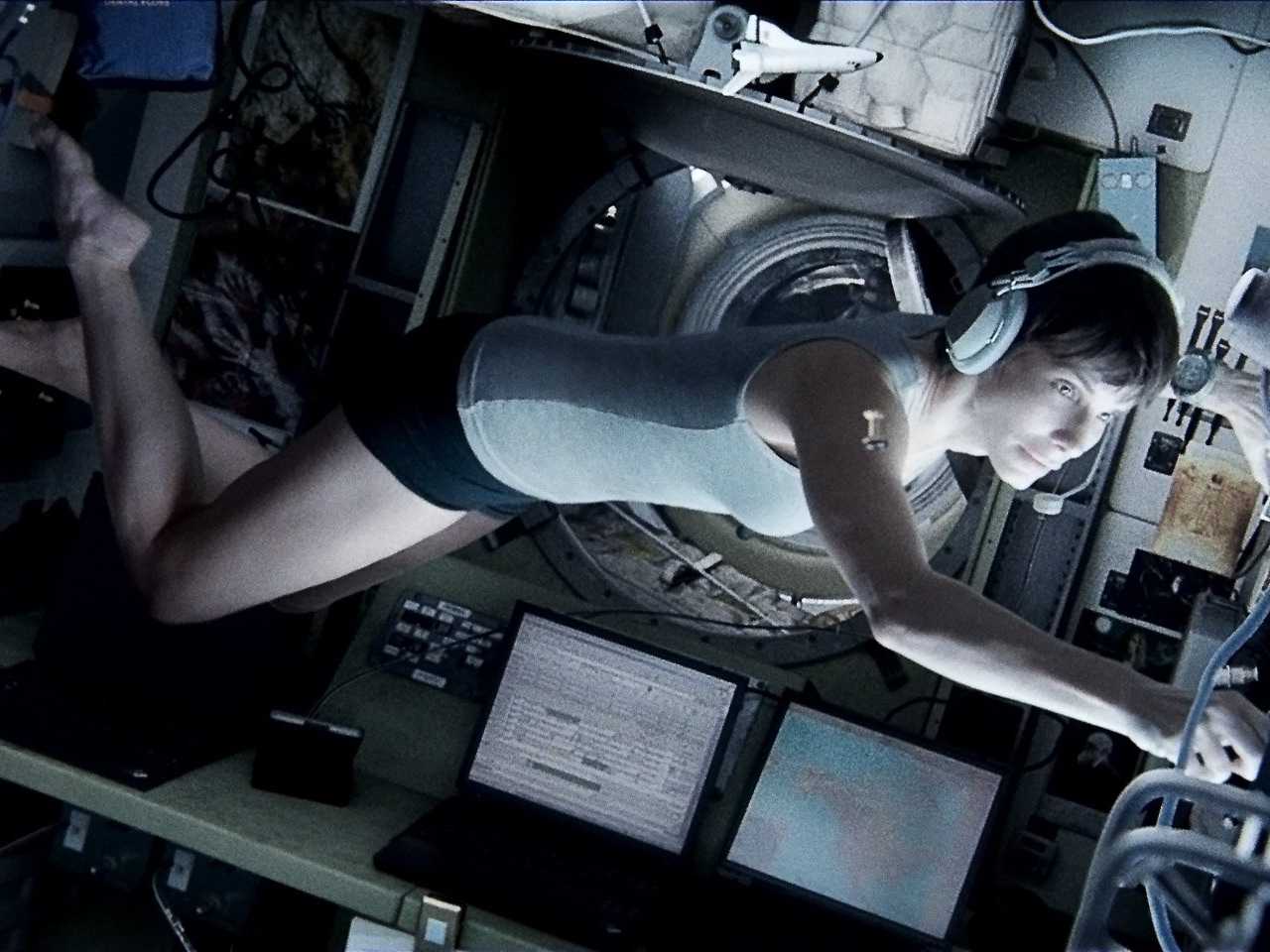
According to Dr Leroy Chiao, who has been on 3 shuttle missions and has also commanded the International Space Station, a real spacesuit is incredibly heavy and cumbersome. “When you’re up there, you normally need a buddy to help you take it off because it’s surprisingly difficult to wriggle in and out of in zero gravity. It can take 15 minutes on a good day,” he says.
As an astronaut on a space mission, you’re supposed to wear a liquid cooling and ventilation garment beneath the suit to keep your temperature stable. And you’re not done yet; you also have to wear an adult diaper! “Trust me, it’s not a good look,” he adds.
Scientific verdict: False
Also Read: How Does It Feel To Be Inside A Spaceship?
Using A Fire Extinguisher As A Hand-held Jetpack

Dr. Stone, in a bid to reach the Tiangong, uses a fire extinguisher as a hand-held jetpack to propel herself in the desired direction. While such an improvisation using a fire extinguisher is possible (and quite ingenious too!), maneuvering it would be much more difficult and uncontrolled than what the movie depicts.
Scientific verdict: True, but highly improbable
90 Minutes’ Orbital Time
Objects at the altitude at which the crew members of Explorer are operating do indeed have an orbital time of 90 minutes; in other words, it would take an object an hour and a half to complete one revolution around Earth in that orbit.
Scientific verdict: True
The “You Have To Let Me Go” Moment

This is a very emotional and hotly debated part of the movie; both Dr. Stone and Kowalski (who are connected by a tether) are drifting uncontrollably past the ISS when Dr. Stone gets entangled in Soyuz’ parachute cords and decelerates. She also manages to grab hold of an end of Kowalski’s tether. Now, both these charatcters are (somewhat) stationary, but Kowalski realizes that the cords can’t support both of their body weights and asks her (rather emotionally) to let him go.
Keen scientific observers claim that since both Dr. Stone and Kowalski are weightless, stationary and have the same angular momentum, all Dr. Stone had to do was give the tether a gentle tug to pull Kowalski towards her.
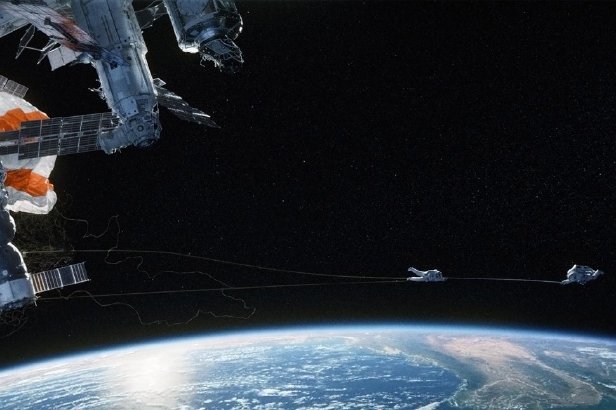
However, according to the film’s science adviser, Kevin Grazier, and NASA engineer Robert Frost, they are still decelerating when they get caught up in the cords. Hence, they both still have some kinetic energy with them. Therefore, Kowalski believes that the cords are not strong enough to absorb their combined kinetic energies and therefore lets go.
Scientific verdict: True… mostly.
There are a few more aspects of the movie that can be scientifically analyzed. Let us know some of the other things that Gravity gets right (or wrong) in the comments below.
Scientifically accurate or not, Gravity convincingly succeeds at awing its viewers with its breathtaking shots of space and Earth; and with the incredible use of 3-D visual effects, it definitely makes you feel the dread of being lost in the endless expanse of space!
Also Read: How Close Must You Come To Earth To Be Influenced By Its Gravity?
How well do you understand the article above!

References (click to expand)
- Gravity (2013 film) - Wikipedia. Wikipedia
- 'Gravity' movie gets the science mostly right. University of California, Los Angeles
- Gravity Fact Check: What the Season's Big Movie Gets Wrong. Time
- Here's what 'Gravity' gets right and wrong about space. The Washington Post
- What Does A Real Astronaut Think Of 'Gravity'? - Forbes. Forbes
